Hanna-Barbera (1972), Warner Home Video (June 5, 2007), 4 discs, 569 mins plus supplements, 1.33:1 original full frame ratio, Dolby Digital Mono, Not Rated, Retail: $44.98
Storyboard:
In the midst of a cultural revolution, one man does his best to hold his family and his sanity together.
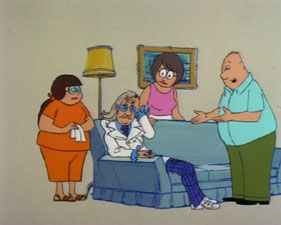
The Sweatbox Review:
Okay, let me get this straight. We can’t have Huckleberry Hound: Volume Two, but Warner expects this DVD set to sell? When Wait Till Your Father Gets Home: The Complete First Season was announced, I know that I was ecstatic, but I do have to admit to being astounded as well. Compared to so many other Hanna-Barbera shows still in the vaults, this one seems pretty obscure (although I understand it is getting some airtime on Boomerang). However, I really do hope that this show finds an audience on DVD, because it is really quite remarkable.
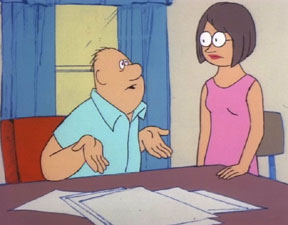
This show has so many unique things going for it. It aired for two seasons (1972-1974) in syndication as the only primetime animated show (depending on the region it was being aired in) to appear in-between The Flintstones’ final season and The Simpsons’ first, and it has a decidedly adult tone. The series’ strength is its writing, and indeed there is very little action in a typically talky episode. The subjects that are discussed are also a bit amazing, looking at the show now having gone through a repressive decade or two since. The show tackles the issues of the day squarely; in fact, the show largely exists to explore such topics as the sexual revolution, gender relations, race relations, the Viet Nam War and the draft, adultery, the Cold War, and the emergence of alternative lifestyles of all sorts. The fact that this show was produced by Hanna-Barbera, the same studio known for cranking out low-rent Saturday morning cartoons at the time, makes the appearance of this show on the cultural landscape makes it just that much more interesting.
Of course, anyone familiar with the Hanna-Barbera studio’s complete history will understand that they were often trailblazers, coming up with television’s first original half-hour cartoon show, and its first primetime animated series. Although much of what the studio did in the 1970s was admittedly geared towards simply filling half-hours for the networks and keeping animators employed, Joe and Bill were still looking for challenges. Therefore, they were receptive when writers Harvey Bullock and Ray Allen pitched the show to them. Bullock and Allen had done previous work for the studio, but were also known for writing on the edgy series Love, American Style. They came up with an idea for an animated show that would explore the turbulence of the times, and do it more boldly than a live action show would likely be able to get away with. Thus, a segment was produced for Love, American Style, entitled Love And The Old-Fashioned Father, which served as a pilot for the series.

Wait Till Your Father Gets Home features the Boyle family, led by the dad, Harry. Harry is a business owner who, like many of his generation, still believes in The System. Harry is not necessarily a passionate defender of the status quo, but at the same time he just doesn’t understand why his kids seem to be so against it. His wife Irma , again like many of her generation, remains traditional while still finding some aspects of this new women’s liberation enticing. The largest conflicts in the household are between Harry and his two oldest children. Chet is a 22-year old college graduate who cannot muster up much interest in anything, least of all working. His lack of motivation is a constant source of frustration to his hard-working dad, as are his liberal views. Daughter Alice, who turns sixteen during the course of the first season, is not much better in Harry’s eyes. She is every bit as liberal, but more aggressive about it, particularly in the areas of feminism and sexuality. The youngest Boyle, little Jamie, is the exception when it comes to the Boyle children. Jamie is every bit the capitalist, interestingly making him the ideal age to mature in the money-driven “me” Eighties. Jamie is also an opportunist, utilizing any family quarrel to his own advantage, such as accepting bribes to leave the room during adult discussions.
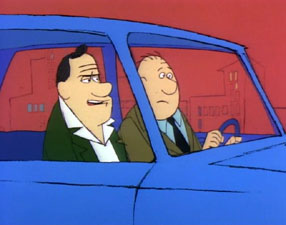
Adding additional spice to the show is Harry’s next-door neighbour Ralph Kane. Though Ralph is basically a friend of Harry’s, they share almost nothing in common in terms of temperament or ideology. While Harry is content to guide his family through the choppy waters of the Seventies, Ralph is battling everything about the ongoing cultural revolution. He is mainly concerned with the Red Menace, seeing “Russkies” everywhere, but he is generally highly suspicious of anyone or anything he deems “un-American,” including anyone who doesn’t look like him. Ralph leads a local militia that proclaim themselves to be vigilantes, though they’re really just harmless redneck crackpots. Only one of his followers achieves any sort of starring role her herself, and that’s Sgt. Whitaker, an older lady who seems as interested in finding a boyfriend in this free-love world as she is about fighting Commies.
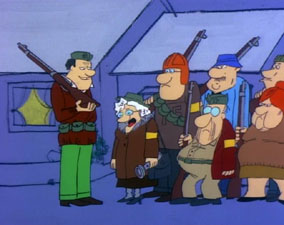
In keeping with the unique nature of the show, an outside cartoonist was brought in to design the characters. Where Hanna-Barbera had previously used comic book artists like Doug Wheatley or Alex Toth to help design their adventure shows, this time gag artist Marty Murphy, who did cartoons for Playboy among other magazines, was asked to design the characters for Wait Till Your Father Gets Home. After this, production designer Iwao Takamoto did the final animation designs. The result was a show that looked like no other Hanna-Barbera program. The sketchy backgrounds may be reminiscent of shows like Hong Kong Phooey or Inch High Private Eye, but the overall sense was that of a magazine gag cartoon come to life. In this sense, I was most reminded of the Studio Ghibli film My Neighbors The Yamadas. Watching the special features gave me a better appreciation for the show’s design, as I initially figured this was not Mr. Takamoto’s finest hour. The sparse backgrounds and sometimes abstract style takes getting used to, but understanding the intent here goes a long ways in coming to appreciate and even like it.
Incidentally, by this time, Hanna-Barbera was successful enough that it had to farm some of the production work to other studios. At least a number of episodes of Wait Till Your Father Gets Home were done in Vancouver at Canawest Studios who also did some Beatles cartoons. The animation is decent when it needs to be, but there is far more talking than action.
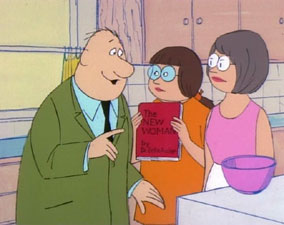
All of this is interesting enough, but how does the show stack up? Wonderfully, it turns out. The writing here is as sharp as any I’ve seen on a television series, making this a contender for funniest Hanna-Barbera series. Of course, comparing Wait Till Your Father Gets Home to Yogi Bear is an apples and oranges scenario, so I won’t attempt to make any strong proclamations. However, there is no doubt that the combination of wit, one-liners, and perfect delivery is extremely strong here. Harry’s voice is provided by Tom Bosley, not long before he saw another Love, American Style skit turn into a starring vehicle for him, with the debut of 1974’s Happy Days. Bosley’s voice work is impeccable, making Harry never less than endearing as the man who witnesses his world changing minute to minute, taking the changes with alternating tantrums and shrugs. Whether dealing with his daughter wishing to go bra-less, his son’s deciding to live with a girl out of wedlock, his wife’s accusations of infidelity, or the ravings of his nutty Commie-fighting neighbour, Harry is always the decent guy from down the street. It is easy to see how, despite numerous disagreements, his kids always show their love for him I the end.
The only thing about this show that I can’t stand? That darn typo that is a part of the title! You “till” a garden, darn it! When you abbreviate “until”, then it’s spelled “ ‘til.“ Well, if that’s my biggest complaint, then I guess I really liked the show. And I really did, too. I can’t think of another show that better captured its time. Everyone always mentions All In The Family at this point, and that’s a pretty good comparison— except that I find Wait Till Your Father Gets Home even funnier.
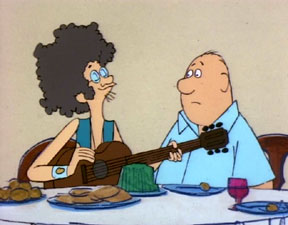
Is This Thing Loaded?
There are just a couple of featurettes on this four-disc set, but they perfectly capture what is unique about the show. Animation For The Nation (10.00) discusses the times in which the show was made, and how the issues of the day were reflected in it. A diverse collection of commentators was chosen to appear, including Gary Owens from Laugh-In, retired Governor Gray Davis, cultural historian Mary F. Corey, Hanna-Barbera book author Michael Mallory, and musician Leif Garrett. The piece may sound contrived, but actually does a good job at filling the viewer in on the early 1970s. Even better is Illustrating The Times (6:30), which delves into the show’s art style. The chief men responsible both appear. I was grateful that Iwao Takamoto could be interviewed for this set before he died, and Marty Murphy makes just as strong a contribution to the proceedings. The history of the show is given, and many pieces of production artwork and preliminary sketches are shown.
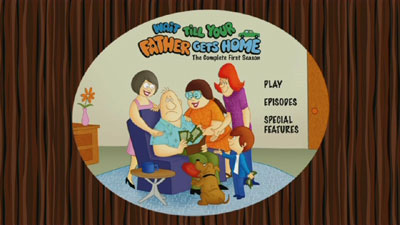
No commentaries or separate art galleries are offered, but all things considered I was left pretty satisfied. The last item on the Special Features menu is for Trailers. These include ones for the upcoming highly-anticipated Popeye set; a “Classic Cartoons From The Vault” selection which goes over Droopy, Birdman, and Space Ghost; and a joint Animaniacs and Pinky And The Brain Volumes 3 spot.

Case Study:
Warner has settled into a new routine with their four-disc Hanna-Barbera releases. As with Magilla Gorilla, a cardboard slipcase fits over a foldout digipack with an overlapping disc design. The flower motif sets the mood appropriately for this otherwise no-frills package that suits the show fine. The biggest break from tradition here is that there are no longer stars decorating the case as with previous H-B releases. Instead, there are brown vertical stripes that seem to suggest a curtain.
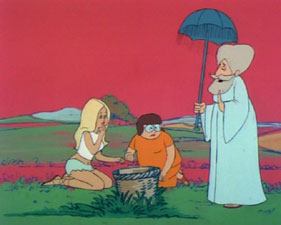
Ink And Paint:
The transfer is sharp enough to reveal the many smudges that were left on the cels when they were photographed, revealing the low-budget nature of the enterprise; but the overall appearance is certainly drab and dingy. This may be the best the show ever looked, but it ain’t too pretty. I did eventually learn to appreciate the look of the show, but it took a bit of an effort given the softness of the transfers. Compression issues don’t surface, but there looked to be a little edge enhancement at times that led to haloing. The picture is naturally in the 4:3 ratio. Colors reflect the intent of the production designer, being somewhat subdued. There are no worries about fine detail here, as this show has none visually. One oddity worth noting is that the third episode on Disc Three, The Prowler, is inexplicably dark making it difficult to enjoy.
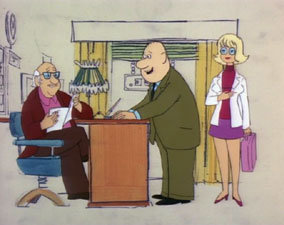
Scratch Tracks:
The mono tracks are predictably thin but acceptable. If they seem a little flat, it may be due to the recording equipment used at the time. As the show is such a product of its time, it actually feels right that it show its age. Worth noting is the use of a laugh track, certainly typical for comedies of that time, but odd now in this day of non-laugh tracked animated programs. This seems to be something of a budget release for Warner, as there are no subtitles, and no other language tracks.

Final Cut:
Drab visual presentation aside, I greatly enjoyed my first-ever viewing of Wait Till Your Father Gets Home, nicely enhanced with just enough supplementary material to explain the show’s place in history. I found it to be a really remarkable program in its devotion to its own place in history. Far from shying away from hot topics of the time, the show became about them. For anyone wanting to learn more about life in 1972, they could do worse than hook up with this set. The topicality of the show wouldn’t count for much if the writing was dull, but in fact this is one of the sharpest written shows I’ve ever enjoyed, and certainly has to be a high point for Hanna-Barbera. For a long-time H-B fan, seeing this show now has been a revelation.
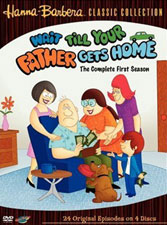 | ||
 |






